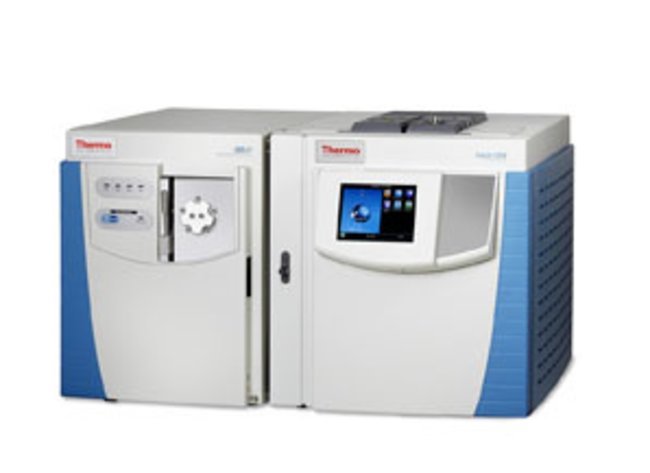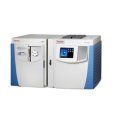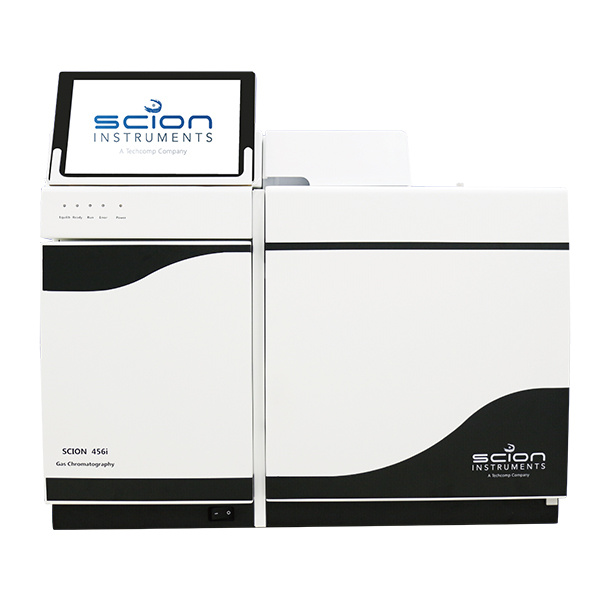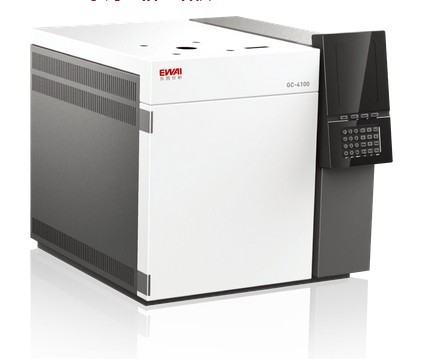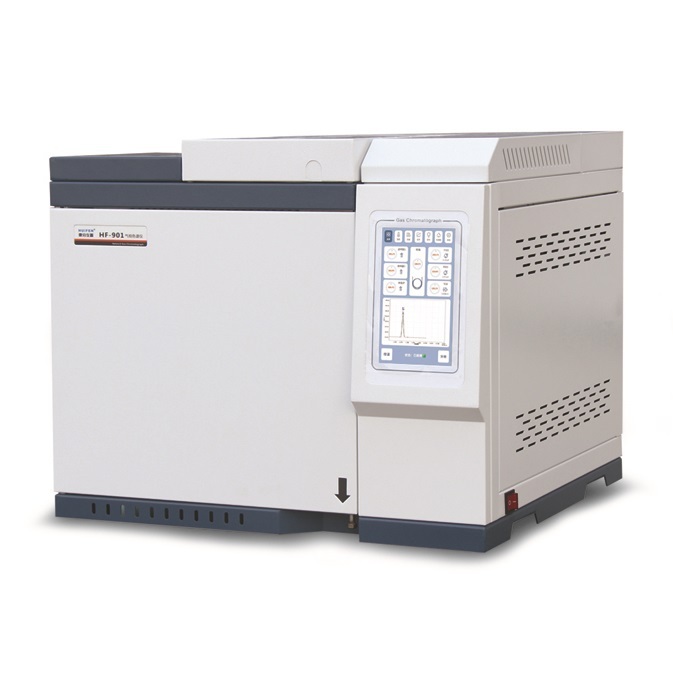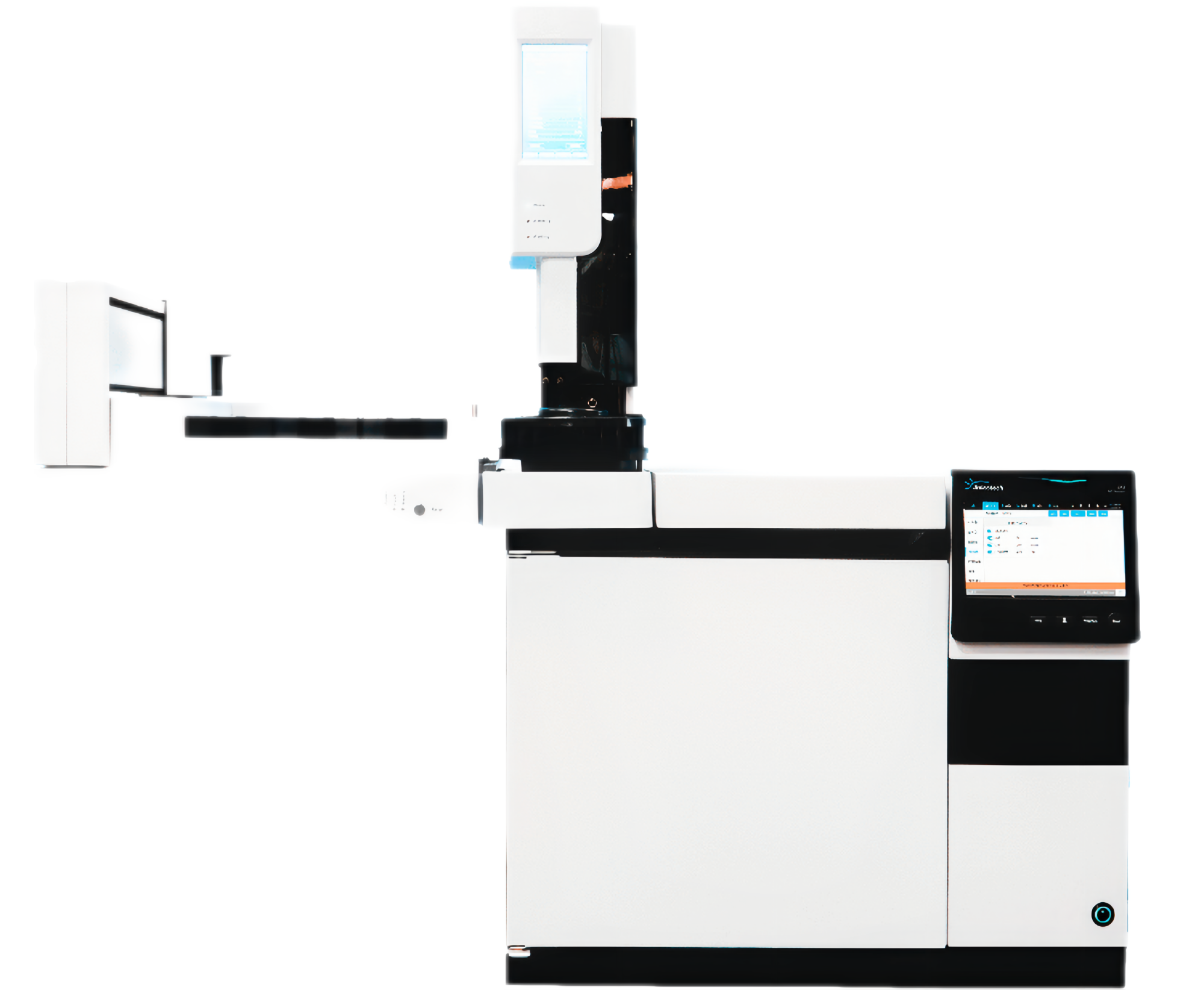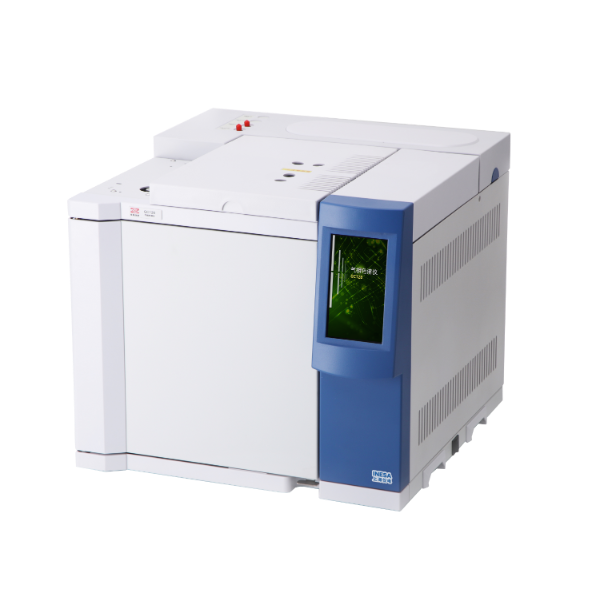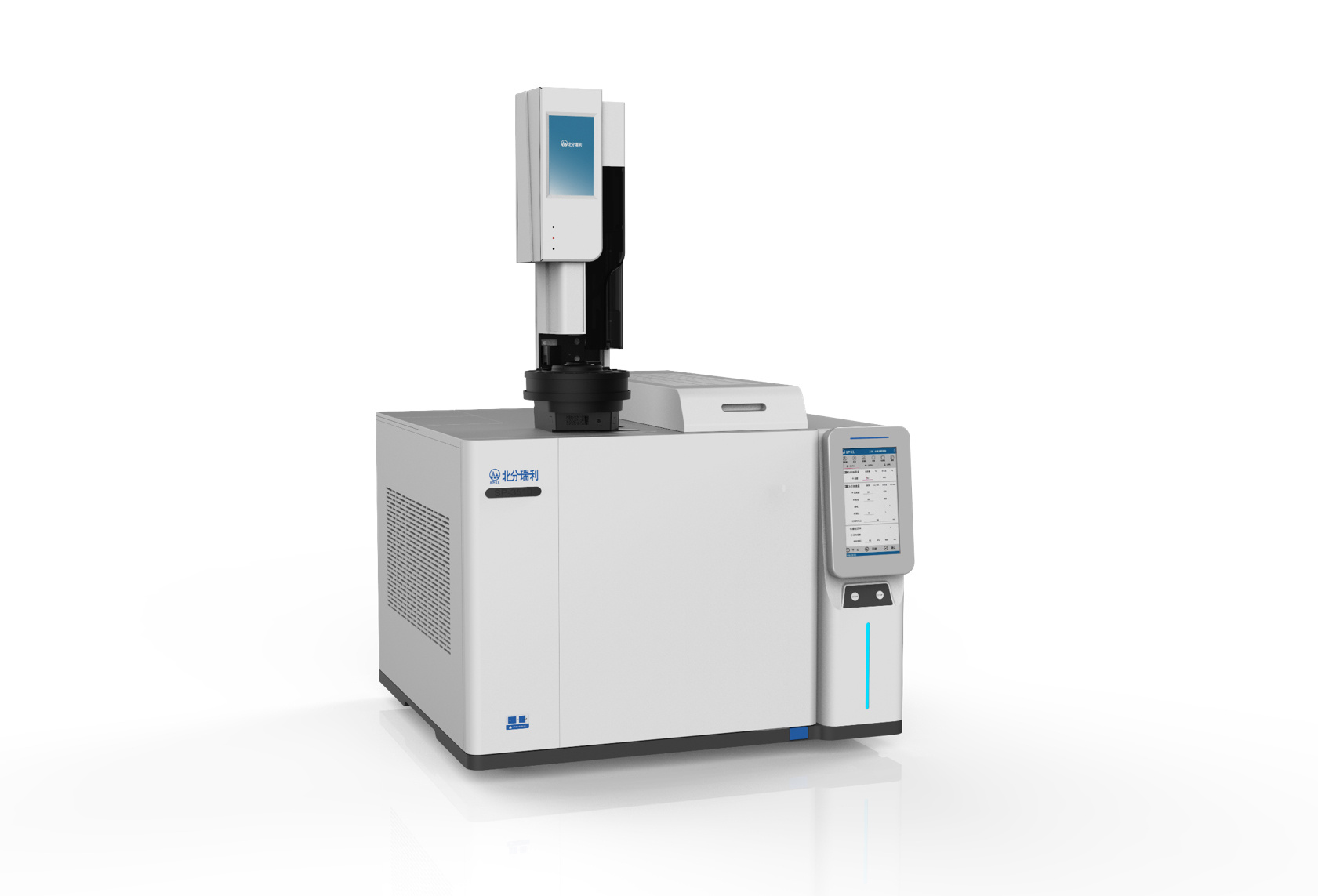方案详情
文
A 20-30 times more sensitive method than traditional GC-
ECD has been developed and validated for the
determination of PCBs in soil and water. Methods of
analysis were evaluated through determination of
detection limits (down to sub ppb level), quanti?cation
limits (down to few ppb), linearity and repeatability.
Validation was completed by the determination of PCBs
extraction recoveries obtained using Liquid/Liquid and
ASE extraction.
LV-SL has proven to be a reliable tool for trace
analysis in environmental applications, being robust
against “very dirty” samples like soil extracts. LV-SL is theeasiest large volume injection GC technique, since it doesnot require any special hardware or tedious tuning of
operating parameters. Full automation is provided
through the dedicated LV-SL Assistant software.
方案详情

Results and discussionELECTRON CORPORATION 30X Increased Sensitivity in the Determinationof PCBs in Water and Soil by GC-ECD usingLarge Volume Splitless Technique Thomas Porzano and Andrea Cadoppi, Thermo Electron Corporation, Milan, Italy Figure 1: TRACE GC UItralM with TriPlusTM AS Autosampler Introduction Environmental legislations approved by federal agencieslike US EPA, or by European Commission Directives [1,2],aim at the most severe reduction of the PCB levels inwater and soils (≤ 1 ng/kg in the original sample). Thisimplies, for a PCB analytical method to be validated, theachievement of very low detection limits (s 0.5 ng/kg inthe extract). The identification and quantitation of PCBs is mostoften accomplished by gas chromatographic techniquescoupled with Electron Capture Detector (ECD), which hasselective sensitivity to chlorinated compounds.Methodsensitivity can be further amplified using large samplevolume injection into the GC [3]. Among the differenttechniques used for large volume injection, the recentlyintroduced LV-SL [4] has the following advantages: (1) Itis simpler because it allows injections, up to 50 pL, in aconventional split/splitless injector without any special tuning of operating parameters, and (2) it is robust whenanalyzing sample by-products or contaminants, such asthose found in food matrices or soil extracts. It is alsosuitable for the analysis of labile pesticides, and it iscompatible with any GC detector [5]. In this method, the application of Large VolumeSplitless (LV-SL) to GC-ECD is validated for thedetermination of polychlorinated biphenyls (PCBs) in soiland water samples. GC-ECD analyses of 20-30 pL of (1)standard Aroclor mixtures and (2) Liquid/Liquid orAccelerated Solvent Extraction (ASE) extracts of spikedwater/soil matrices are reported. Injections wereperformed with the TriPlus Autosampler; GC oven, andconventional SSL injector conditions were set-up withdedicated software; the analytical method was validatedthrough determination of detection limits, linearity,extraction recoveries, and repeatability. As an outcome, PCBs were detected at ppt level inwater and soil matrices. A 20-30 fold increase ofsensitivity with respect to traditional GC-ECD wasobtained. A large number of injections of complexmatrices can be performed without a significant decreasein chromatographic performance. Principles of Large Volume Splitless injectiontechnique LV-SL injection overcomes the limitation of the maximumsample volume to 1-2 pL of classical splitless injection byexploiting the Concurrent Solvent Recondensation (CSR)technique [4]. This technique is based on the control ofthe evaporation rate in the vaporizing chamber, involvesthe use of a strong pressure increase in the injectorresulting from solvent evaporation (auto pressure surge),and provides a strongly accelerated transfer of the samplevapors from the injector into the inlet of an uncoatedprecolumn by recondensation of the solvent. Concurrent Solvent Recondensation: Steps of the ProcessFive crucial steps denote the LV-SL process (Figure 2): (1) Introduction of the needle syringe a few millimetersinside the injection port and fast injection, minimizingcontact between syringe and injector exploiting liquidband formation: (2) auto pressure surge strongly accelerating transfer ofvapors in the precolumn; Sample Preparation: The extract is dried on anhydroussodium sulfate and purified first with concentrated sulfuricacid and then through a Florisil column. After the clean-up, the sample is evaporated to dryness under nitrogen-flow and recuperated with 0.25-0.5 mL of n-hexane (from400 to 4,000 times sensitivity increase with respect toinitial sample). GC-ECD analysis: Injection of 20 uL in LV-SL modeallows an additional 20-fold sensitivity increase. Figure 3: PCBs analysis (EPA 8082) procedure using the LV-SL technique Experimental Reagents: A series of Aroclor mixtures in n-hexane wereprepared at 2-20 ng/mL values as standard solutions.Standard LV-SL solutions were prepared at different levelsof concentration from 1.6 to 36 ppb. Test samples wereprepared by spiking (level from 10 ng/L in water to 10ug/kg in soil) negative-to-PCBs environmental samples,purified and re-concentrated at about 2-40 pg/L accordingtxxr)o US EPA 8082 (see Figure 3 and text below). Materials: Splitless and Large Volume Splitlessinjections were performed with a TriPlus Autosampler(Thermo Electron) on a TRACE GC Ultra (ThermoElectron) equipped with ECD detector (Figure 1). GC Methods: LV-SL oven method was determinedwith LV-SL Assistant software (Thermo Electron). (SeeFigure 4 and text below). GC parameters are reported inbox chromatograms. Autosampler Method: 1.0 pL in SL, 30 pL with LV-SL.Minimum injection depth in the injector and 100 pL/secinjection speed (cold needle mode). PCBs analysis (US EPA 8082) procedure using the LV-SLtechnique (Figure 3) Waters extraction: 1 L of sample is extracted twice withmethylene chloride, 100 mL in a separation funnel. Soils extraction: 20 g of sample is first air-dried thenuniformly mashed and mixed with hydromatrix to removemoisture and increase surface for the extraction withsolvent. A methylene chloride/acetone 1:1 mixture, 120mL, is used to extract PCBs with Accelerated SolventExtraction (ASE@ 300, Dionex Corporation) equipmentaccording to US EPA 3545. Large Volume Splitless Software GC oven method for LV injections was created with theaid of the Large Volume Splitless Assistant software.Depending on the analytical parameters (like solvent typeand volume to inject) the Assistant allows for theprediction of how long the initial isotherm of thetemperature program should last to achieve the best LV-SLperformance. Figure 4 shows the estimated time (about 2minutes) when injecting 20 pL of n-hexane in a GCequipped with a 60 m column, 0.25 mm ID. Figure 4:Front-page of the LV-SL Assistant with determination of ovenmethod parameters suitable for the injection of a 20 pL n-hexane solution.This software provides the maximum initial oven temperature for a solventat given conditions of carrier gas pressure and calculates the minimum oveninitial time. Setting of these parameters ensures that the pressure surge isautomatically generated, thus granting a quick transfer of the vapors into thepre-column, while the calculated minimum oven time enables a propersolvent trapping effect to occur into the pre-column. Validation (step 1): LV-SL analysis of aroclor standards Figure 5 reports the chromatogram of 30 pL injection of a2 ppb solution of Aroclor 1242/1254/1260 1:1:1 in n-hexane. Congeners 30 (2,4,6-Trichlorobiphenyl) and 209(Decachlorobiphenyl), added at a concentration of 3 ppb,were used as markers for the identification of 5 congenersfor each Aroclor mixture. Figure 5: LV-SL analysis of Aroclor standards. Validation (step 2): detection limits, recoveriesand linearity Four Aroclor 1260 solutions, 20 pL injection volume,concentration ranging between 1.6 and 32 pg/L, wereinjected to verify the calibration curve linearity (Figure 6).The MDL (Method Detection Limit) was estimatedaccording to CFR regulation [6] using the formula: MDL= Student’s t value x Standard Deviation. The standarddeviation was evaluated on a sequence of seven injectionsat the lower level of concentration. The Student’s t value isreferred to 6 degrees of freedom (3.143). The EQL(Estimated Quantification Limit) is defined as 3 times theMDL. Recoveries were evaluated on (1) extract of 1 L ofsurface water spiked with Aroclor 1260 mixture, 10 ppt;(2) extract of 20 g of soil sample spiked with Aroclor1260 mixture, 20 ppb. Recoveries were respectively 105%and 110% for the water and soil samples. Validation (step 3): standards repeatability LV-SL performance was evaluated by seven consecutive 30pL injections (see example in Figure 5) of 2 ppb solutionof Aroclor 1242/1254/1260 1:1:1 in n-hexane,added withcongeners 30 and 209 (3 ppb) for identification of at least5 typical congeners for each Aroclor mixture. ECDabsolute peak areas show deviations between 1 and 3%(Table 1). Standard deviations of retention times were, onaverage, around 0.002 minutes. Congener RETENTION TIMES ABSOLUTE PEAK AREAS IUPAC number Mean (min) SD (min) Mean (counts) RSD% 90 23.695 0.002 1.9E+05 1.3% 77 24.359 0.001 1.8E+05 2.0% 132 27.288 0.002 4.0E+05 1.1% 179 27.732 0.002 1.1E+05 1.9% 141 27.828 0.002 2.9E+05 1.0% 158 28.399 0.002 1.7E+05 1.3% 138 28.475 0.002 4.3E+05 1.2% 187 28.790 0.002 2.6E+05 1.3% 183 28.969 0.002 1.3E+05 2.1% 180 30.636 0.002 5.7E+05 1.8% 170 31.852 0.002 3.4E+05 0.8% 194 33.815 0.003 1.2E+05 0.9% 206 34.904 0.002 3.7E+04 2.9% Table 1: Retention Times and Peak Areas repeatability of 7 consecutivestandard analyses LV-SL analysis of real samples Analyses of real water and soil samples at unknown PCBconcentration were performed according to the methodthus far (for method details see Figure 3). Figure 7 showsa 20 pL injection of a 0.5 mL n-hexane solution obtainedafter extraction of 20 g of soil coming from acontaminated area of Northern Italy. Overlapping of thereal sample with the analysis of 20 pL standard Aroclor1260 20 ppb shows an impressive match. The overallconcentration evaluated on the initial dry soil is 2.5 ug/kg. igure 7: Real soil sample analysis compared with standard Aroclor 1260 A 20-30 times more sensitive method than traditional GC-ECD has been developed and validated for thedetermination of PCBs in soil and water. Methods ofanalysis were evaluated through determination ofdetection limits (down to sub ppb level), quantificationlimits (down to few ppb), linearity and repeatability.Validation was completed by the determination of PCBsextraction recoveries obtained using Liquid/Liquid andASE extraction. LV-SL has proven to be a reliable tool for traceanalysis in environmental applications, being robustagainst “very dirty”samples like soil extracts. LV-SL is theeasiest large volume injection GC technique, since it doesnot require any special hardware or tedious tuning ofoperating parameters. Full automation is providedthrough the dedicated LV-SL Assistant software. Acknowledgements This application has been developed in cooperation withSonia Dall’Ara, Elisa Montanari and Gian Piero Luciani,from AgriParadigma, Ravenna (taly). ( 1. CFR (Code of F ederal R egulation) Title 40, Part 180; US EPA Method 8082; EPA method 1662. ) ( 2. European Commission D irective 1996/59/EEC and u pdates; COM(2001) 5 93; D irective 2002/201/E C and updates. ) ( 3. H. G.J. M ol & al, Journal of H i gh Resolution Chromatograpby 1996, 1 9,69-79 ) ( 4 . P. Magni & T . Porzano, Journal of Separation Science 2003, 26,1491-1 4 98 ) ( 5. T. Porzano & al. , Proc. 27th Int. Symp. Capillary Chromatography, D 15, Riva d e l Garda, Italy, M ay 3 1 -June 4, 2004, ed. P. Sandra ) ( 6. CFR Title 40, Part 136, Appendix B. ) In addition to theseoffices, Thermo ElectronCorporation maintainsa network of represen-tative organizationsthroughout the world. Australia +61 28844 9500 Austria +431333 50340 Belgium +3224823030 Canada +1800 532 4752 China +86 10 5850 3588 France +331 60 92 48 00 Germany +49 61034080 India +91 22 2778 1101 Italy +39 02 950 591 Japan +8145 4539100 Netherlands +31 76 587 9888 Scandinavia +46855646800 South Africa +27 11 570 1840 Spain +3491 657 4930 Switzerland +4161 48784 00 UK +441442 233555 USA +1 800 532 4752 www.thermo.com ISO 9001 DNV-CERT-00203-94-AQ Thermo Electron S.p.A. Milan, Italy is ISO Certified. @2005 Thermo Electron Corporation. All rights reserved. Florisil is a registered trademark of U.S. Silica Company. ASEis a registered trademark of Dionex Corporation. All other trademarks are the property of Thermo Electron Corporation and its subsidiaries. Specifications, terms and pricing are subject to change. Not all products are available in all countries. Please consult your local sales representative for details. AN10136_E 12/05C Environmental legislations approved by federal agencieslike US EPA, or by European Commission Directives [1,2],aim at the most severe reduction of the PCB levels inwater and soils (< 1 ng/kg in the original sample). Thisimplies, for a PCB analytical method to be validated, theachievement of very low detection limits (< 0.5 ng/kg inthe extract). The identification and quantitation of PCBs is mostoften accomplished by gas chromatographic techniquescoupled with Electron Capture Detector (ECD), which hasselective sensitivity to chlorinated compounds. Methodsensitivity can be further amplified using large samplevolume injection into the GC [3]. Among the differenttechniques used for large volume injection, the recentlyintroduced LV-SL [4] has the following advantages: (1) Itis simpler because it allows injections, up to 50 µL, in aconventional split/splitless injector without any specialtuning of operating parameters, and (2) it is robust whenanalyzing sample by-products or contaminants, such asthose found in food matrices or soil extracts. It is alsosuitable for the analysis of labile pesticides, and it iscompatible with any GC detector [5]. In this method, the application of Large VolumeSplitless (LV-SL) to GC-ECD is validated for thedetermination of polychlorinated biphenyls (PCBs) in soiland water samples. GC-ECD analyses of 20-30 µL of (1)standard Aroclor mixtures and (2) Liquid/Liquid orAccelerated Solvent Extraction (ASE) extracts of spikedwater/soil matrices are reported. Injections wereperformed with the TriPlus Autosampler; GC oven, andconventional SSL injector conditions were set-up withdedicated software; the analytical method was validatedthrough determination of detection limits, linearity,extraction recoveries, and repeatability.A 20-30 times more sensitive method than traditional GC-ECD has been developed and validated for thedetermination of PCBs in soil and water. Methods ofanalysis were evaluated through determination ofdetection limits (down to sub ppb level), quantificationlimits (down to few ppb), linearity and repeatability.Validation was completed by the determination of PCBsextraction recoveries obtained using Liquid/Liquid andASE extraction.LV-SL has proven to be a reliable tool for traceanalysis in environmental applications, being robustagainst “very dirty” samples like soil extracts. LV-SL is theeasiest large volume injection GC technique, since it doesnot require any special hardware or tedious tuning ofoperating parameters. Full automation is providedthrough the dedicated LV-SL Assistant software.
确定
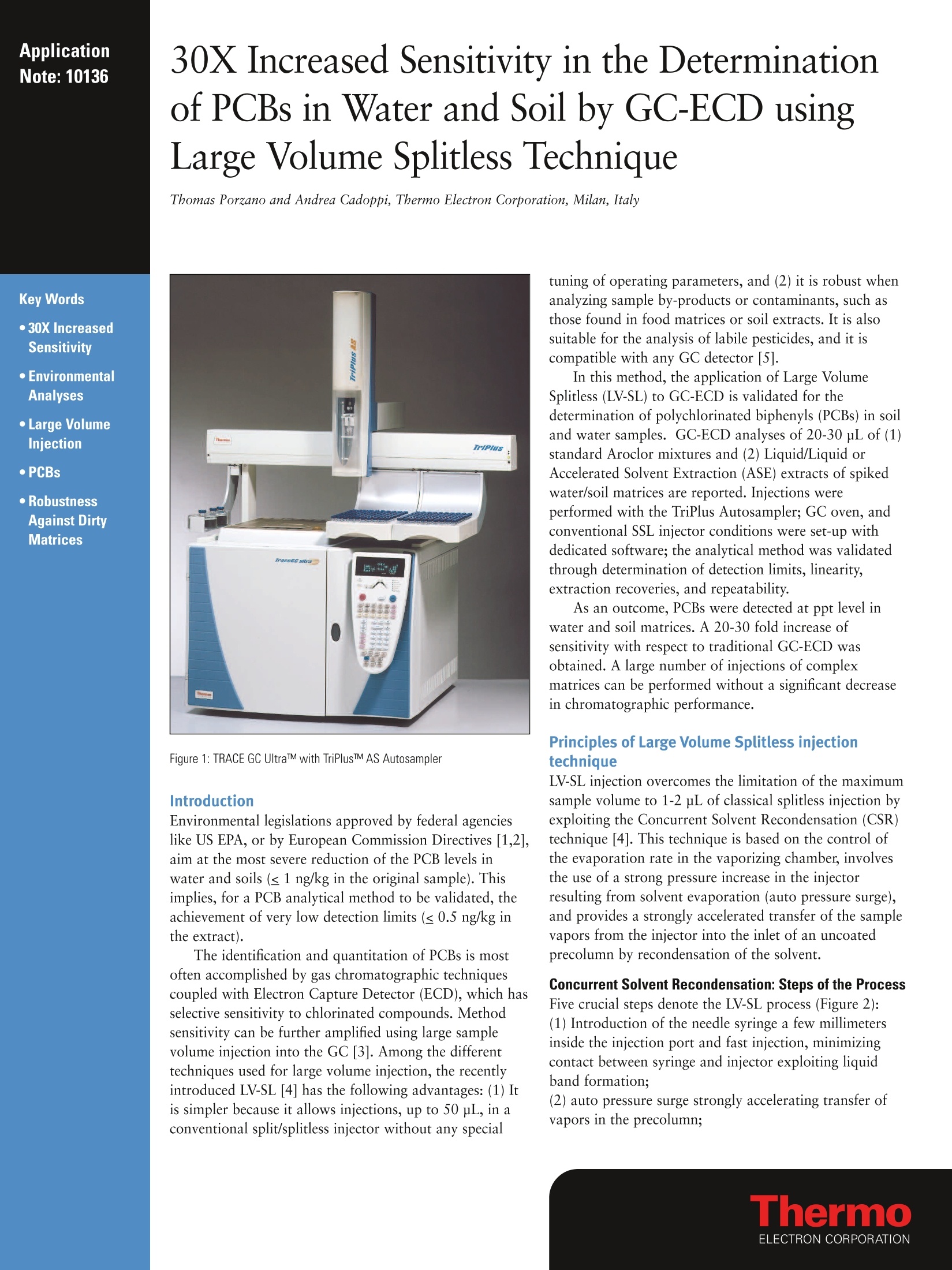
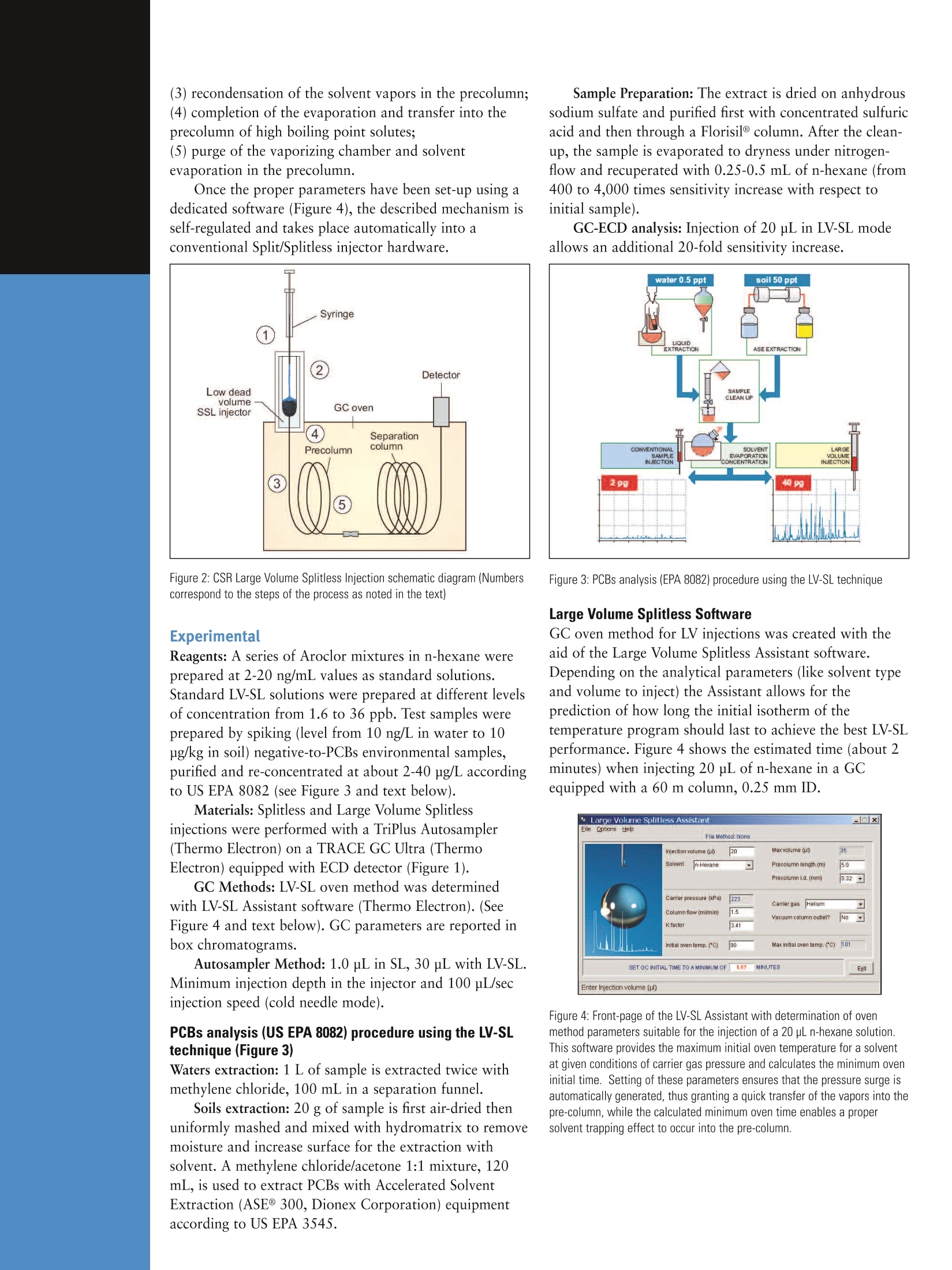

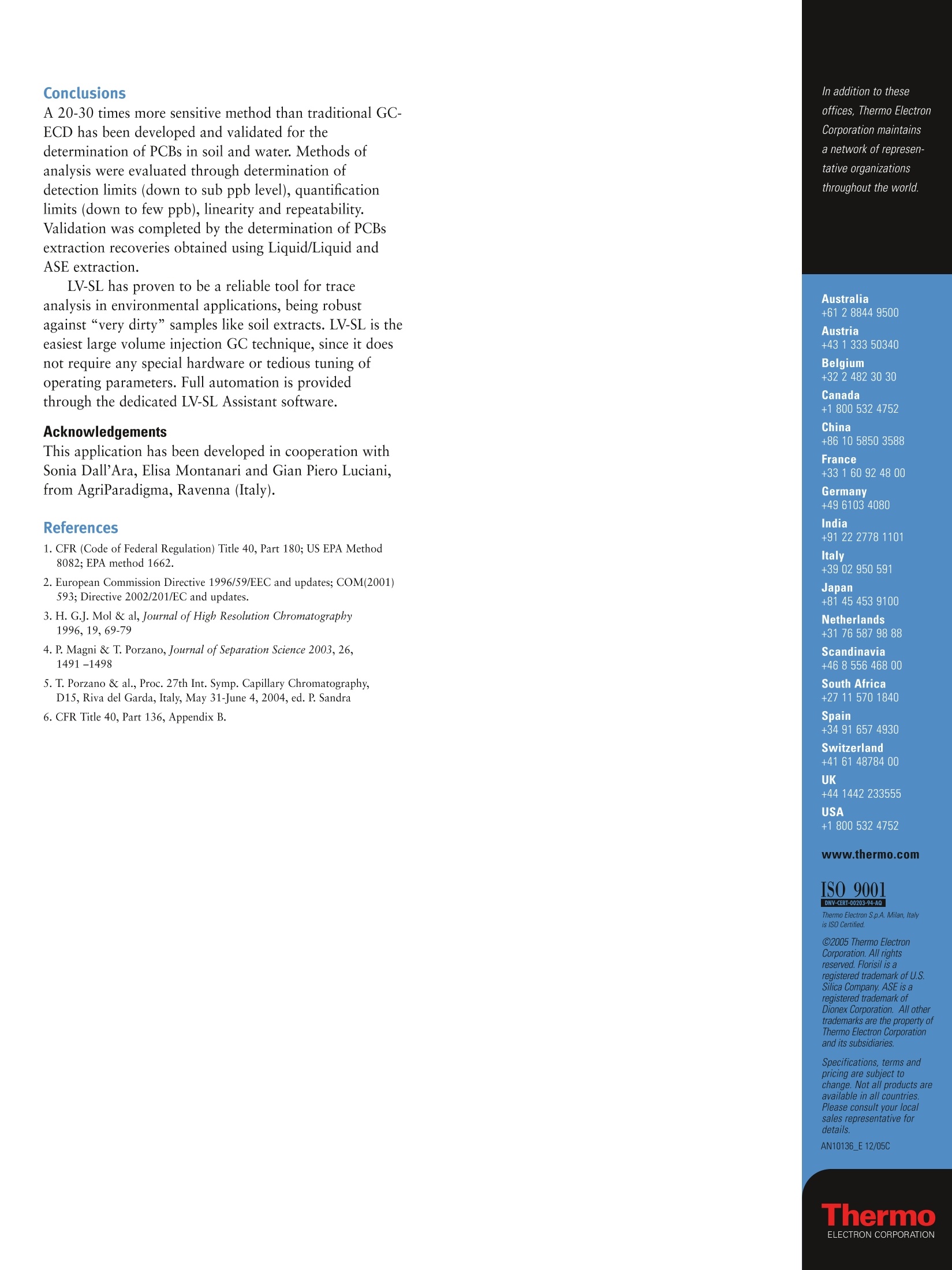
还剩2页未读,是否继续阅读?
赛默飞色谱与质谱为您提供《水和土壤中多氯联苯检测方案(气相色谱仪)》,该方案主要用于土壤中有机污染物检测,参考标准--,《水和土壤中多氯联苯检测方案(气相色谱仪)》用到的仪器有赛默飞TRACE 1310 气相色谱仪
推荐专场
相关方案
更多
该厂商其他方案
更多

